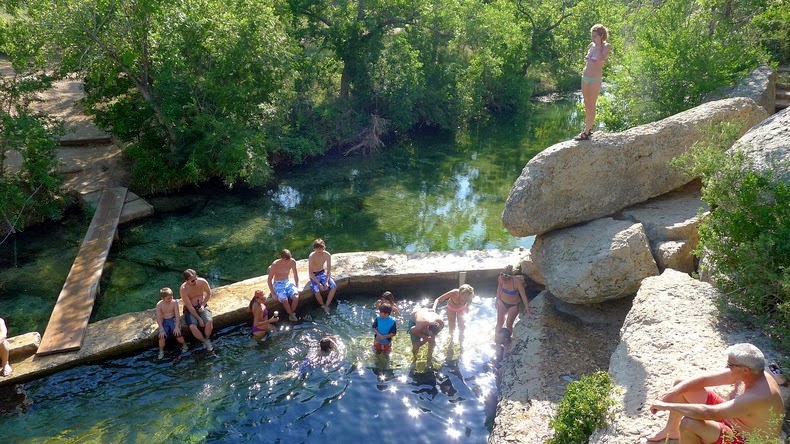Jacob's Well in Texas Hill Country is a perennial karstic spring located on the bed of Cypress Creek in Wimberley. The mouth of the well is four meters in diameter through which thousands of gallons of water surges up per minute feeding Cypress Creek that flows through Wimberley, sustaining Blue Hole and the Blanco River, recharging the Edwards Aquifer, and finally replenishing estuaries in the Gulf of Mexico.
The well was first discovered in the 1850s when a couple of early settlers followed Cypress Creek to its source. They described the crevice in the creek bed which was overflowing with an abundance of clear, cool water as "like unto a well in Bible times." Since then, the location has been a beloved swimming hole for generations, a gathering place for Native Americans and early settlers, and a rich habitat for aquatic species. It is also a popular diving spot for thrill seekers despite the fact that at least nine divers have lost their lives here over the years.

Photo credit: Carl Griffin
Jacob's Well is one of the longest underwater caves in Texas. From the opening in the creek bed, the cave descends vertically for about ten meters, then continues downward at an angle through a series of silted chambers separated by narrow restrictions, finally reaching a depth of forty meters.
Through the years, many have successfully explored the first and second chambers of the well. The first chamber is a straight drop to about 30 feet; then it angles down to 55 feet. Nourished by the rays of sunlight that penetrate the crystal water, this cavern area is bright and is home to algae and wildlife. The second chamber is a long funnel to 80 feet, where there is a restricted opening to the third chamber. Inside the second chamber is a false chimney, which appears to be a way out of the well but has trapped at least one diver. The third chamber is a small room with a floor of unstable gravel. Divers must inflate water wings to navigate this chamber successfully, trying not to stir up silt or dislodge the gravel.
The passage into the fourth chamber is very tight. The few who have seen the fourth chamber say it is "virgin cave" with fantastic limestone formations and no gravel. Covering the bottom is fine silt that can totally obscure vision when kicked up by one misstep.
Ironically, there was a time when it was impossible to descend into Jacob's Well. "There's a picture of me at 3 years old at Jacob's Well in the family album," recalls 79-year-old historian Dorothy Wimberley Kerbow. "My dad would throw me into the well. You couldn't sink down because the spring would just bubble you up with such force."
Kerbow recalls that she and her friends would often visit Jacob's Well in the 1950s, and it was impossible to go more than two feet below the surface due to the force of the spring.
In 1924, Jacob’s Well was measured to have a flow of one hundred and seventy gallons per second (six hundred and forty liters per second) discharging water six feet into the air. Over the years, the well’s flow had diminished allowing divers to reach the deepest chambers. The spring ceased flowing for the first time in recorded history in 2000, and again in 2008.
The first time the spring stopped flowing, the event was considered by many as symbolic of the region's increasing water shortage and quality problems. “It was a wake-up call for everyone,” recalls landowner David Baker. “We don't want it to turn into Jacob's Cave."
David Baker has given up his home to form the Jacob’s Well Natural Area to restore and protect this sensitive area for future generations.

Image credit: Danny Self

Sources: Visit Wimberley, Jacobswellspring.org, Wikipedia. Photos by Patrick Lewis





















